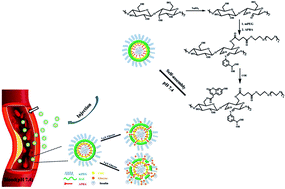Novel amphiphilic glucose-responsive modified starch micelles for insulin delivery†
Abstract
The high pKa (8.26 to 8.6) of PBA has restricted its glucose-responsiveness in physiological conditions, and the high cytotoxicity of polymers is also a limiting problem in their potential application for insulin delivery. Novel amphiphilic glucose-sensitive dialdehyde starch polymers containing 3-aminophenylboronic acid (APBA) as a glucose-responsive group and mPEGylated dialdehyde starch (mPEG-DAS) with hydrophobic 7-hydroxycoumarin-4-acetic acid (Cou) were synthesized. This dialdehyde starch derivative can self-assemble into mPEG-DAS–APBA–Cou micelles with “shell–core” structures in phosphate-buffered saline solution (PBS). In addition, the drug-loaded micelles can release insulin rapidly in response to hyperglycemia in a physiological environment. The results demonstrated that the mPEG-DAS–APBA–Cou micelles showed notable glucose responsive behavior near the physiological range. The insulin release from the nanocarriers is sensitive to different concentrations of glucose, releasing insulin rapidly under the conditions of 3 mg mL−1 glucose while demonstrating comparatively inert release at 1 mg mL−1 glucose (pH 7.4). MTT assays and hemolysis studies both confirmed that the mPEG-DAS–APBA–Cou micelles have low cytotoxic activity to A549 cells and low blood toxicity. These results suggest that the glucose-sensitive dialdehyde starch micelles (mPEG-DAS–APBA–Cou) have potential applications as a glucose-responsive material for insulin delivery.



 Please wait while we load your content...
Please wait while we load your content...